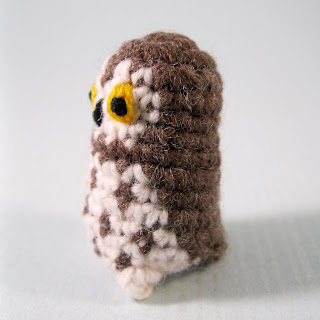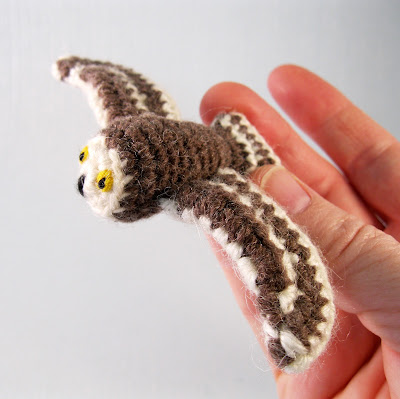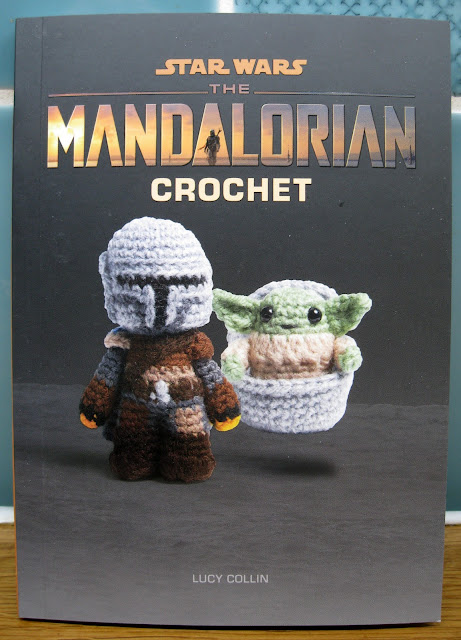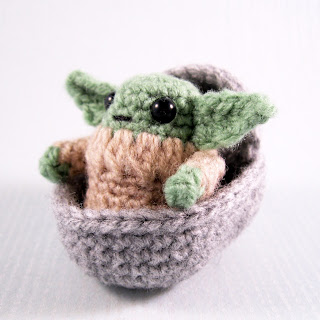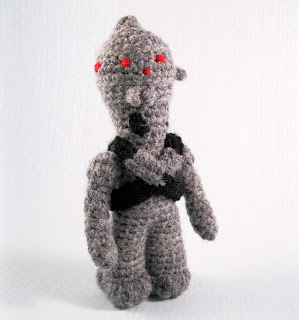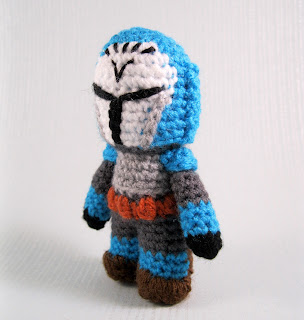As I live in the UK, these are woodland animals that I'm familiar with from Britain, and I've made them in a realistic style, at least as far as I can given their size. Although they're not totally in scale, I've tried to keep them mostly in proportion with each other. They don't use much yarn, so they're good for using up scraps - I made them using acrylic yarn with a bit of wool or alpaca mixed in, to give a nice, soft effect.
Thursday, 24 March 2022
Tiny Woodland Animal Amigurumi Patterns
As I live in the UK, these are woodland animals that I'm familiar with from Britain, and I've made them in a realistic style, at least as far as I can given their size. Although they're not totally in scale, I've tried to keep them mostly in proportion with each other. They don't use much yarn, so they're good for using up scraps - I made them using acrylic yarn with a bit of wool or alpaca mixed in, to give a nice, soft effect.
Friday, 7 January 2022
All About The Mandalorian Crochet Kit
 |
I live in the UK,
so that's where I get all my yarn from. I use double knitting (DK) weight yarn,
equivalent to 3:light weight in the US, and 8 ply in Australia/NZ - there's
a yarn thickness guide on Ravelry
which is very helpful. (By the way, the yarn I used is not the same as the yarn
in the kit. That isn't a particular brand, and was sourced by the publisher
separately).
If you can't get hold of the yarns listed below, you can at least look at them in online stores such as Wool Warehouse or LoveCrafts, which might help you find equivalents closer to home.
5g light grey yarn - HBDK Light Grey Mix (814).
5g black yarn - HBDK Black (965).
10g dark grey yarn - HBDK Slate Grey (633).
5g mid brown yarn - HBDK Chocolate (947).
5g dark brown yarn - RDK Brown (051), alternative SSDK Dark Brown (1004).
Small amount of yellow yarn - HBDK Sunflower (978).
Small amount of beige yarn - HBDK Walnut (927).
Small amount of light beige yarn - HBDK Oatmeal (964).
Small amount of blue yarn - HBDK Denim (994).
Grogu in pram:
5g green yarn - HBDK Grass (825).
10g light beige yarn - HBDK Oatmeal (964).
10g light grey yarn - HBDK Light Grey Mix (814).
Cara Dune:
10g pale peach yarn - HBDK Biscuit (963).
10g teal yarn - HBDK Petrol (829), alternative Peacock (560).
5g dark grey yarn - HBDK Slate Grey (633).
10g black yarn - HBDK Black (965).
10g dark brown yarn - RDK Brown (051), alternative SSDK Dark Brown (1004).
Small amount of light grey yarn - HBDK Light Grey Mix (814).
Greef Karga:
5g black yarn - HBDK Black (965).
10g light brown yarn - HBDK Walnut (927).
10g mid brown yarn - HBDK Chocolate (947).
10g dark brown yarn - RDK Brown (051), alternative SSDK Dark Brown (1004).
5g golden brown yarn - RDK Honey (129), alternative SSDK Camel (1420).
Moff Gideon:
20g black yarn - HBDK Black (965).
5g light brown yarn - HBDK Walnut (927).
5g red yarn - HBDK Soft Red (617).
Small amount of white yarn - HBDK White (961).
Small amount of dark grey yarn - HBDK Slate Grey (633).
Kuiil:
5g pale peach yarn - HBDK Biscuit (963).
5g mid brown yarn - HBDK Chocolate (947).
5g dark brown yarn - RDK Brown (051), alternative SSDK Dark Brown (1004).
5g khaki green yarn - HBDK Olive Green (634).
5g light brown yarn - HBDK Walnut (927) or Taupe (601).
Small amount of silver grey yarn - HBDK Light Grey Mix (814).
15g grey yarn - HBDK Dark Grey Mix (790).
5g black yarn - HBDK Black (965).
Small amount of red yarn - HBDK Signal Red (977).
10g green yarn - HBDK Grass (825).
15g light beige yarn - HBDK Oatmeal (964).
30g mid brown yarn - HBDK Chocolate (947).
10g dark beige yarn - HBDK Walnut (927).
Offworld Jawa:
5g black yarn - HBDK Black (965).
15g dark grey yarn - HBDK Slate Grey (633).
Small amount of dark brown yarn - HBDK Chocolate (947).
Bo-Katan Kryze:
10g pale peach yarn - HBDK Biscuit (963).
10g dark grey yarn - HBDK Slate Grey (633).
10g light grey yarn - HBDK Light Grey Mix (814).
10g russet yarn - HBDK Fox (779).
15g turquoise yarn - HBDK Turquoise (998).
5g black yarn - HBDK Black (965).
10g mid brown yarn - HBDK Chocolate (947).
5g white yarn - HBDK White (961).
Ahsoka Tano:
10g russet yarn - HBDK Fox (779).
10g black yarn - HBDK Black (965).
5g mid brown yarn - HBDK Chocolate (947).
10g dark grey yarn - HBDK Slate Grey (633).
10g blue yarn - HBDK Denim (994).
10g white yarn - HBDK White (961).
5g light grey yarn - HBDK Light Grey Mix (814).
Small amount of maroon yarn - HBDK Claret (841).
*Errata:
On page 47 in the pattern for IG-11, round 3 should read:
Rnd 3: [2 sc in next st, sc in next 2 st] 2 times – 8 st.


















